|
|
| Home | Site Map | Feedback | About Myself | Contact Info |
|
By
Ahmer Ali Rizvi It is time the birdwatchers got their optical equipments ready, and they camped at the edge of prominent wetlands to enjoy the exciting sights and sounds of wild birds. Hundreds of thousands of migratory birds are entering our country these days and they are congregating at our welcoming wetlands. During
early winter, the weather starts getting harsh in northern regions of
the world leaving no choice for wild birds but to leave their home
grounds and move towards comparatively warmer regions in the south. A large population of migratory birds that takes wing from Siberia and other Central Asian states prefers a flyway that passes through Kazakistan, Afghanistan and ends at coastal ranges of Pakistan. This route is also known as Green Route or Indus Flyway. Migratory birds start their journey from the cold north usually at the end of August. By the end of November, most of them have reached the desired destinations in warm South. They spend the whole of winter season on wintering grounds and beat their wings back to their homelands by the end of February. In Pakistan, an estimated population of one million birds migrates during winter. Most of them prefer to stay on various wetlands of Sindh province since there are many large wetland complexes along the Indus River. These freshwater wetlands provide suitable habitats and feeding opportunities to a wide variety of water-birds passing through Indus flyway. Nara canal with associated marshlands in Khairpur, Lung Lake, Hamal Kachri & Drig Lakes in Larkana, Haleji, Hadero and Keenjhar Lakes in Thatta, are some of the prominent and favourite wintering abodes of migratory water-birds. The
migratory waterfowls that inhabit freshwater wetlands include many
members of duck family like Mallards, Pintails, Shovelers, Teals, Wigeon,
Garganeys and Shelducks etc. Other waterbirds that are found on
freshwater lakes are Coots, Moorhens, Gallinules, Waterhen and Grebes
etc. A large population of Shorebirds also reaches in coastal area of
Sindh. These waders include Curlews, Whimbrels, Godwits, Migratory birds add colour and music to the wild during winter. People who love wildlife, especially bird-watching, take the best advantage of this great opportunity to watch these amazing creatures in real. They spend time in the fields watching, identifying and photographing birds. Watching birds, especially the large waterfowls in real is such a fascinating activity that no one can deny experiencing the great pleasure. There are really no words to explain the height of excitement brought on watching pink flamingoes roaming over blue lakes, splashing of Pintail ducks at shallow water surface, synchronised winging of Shoveller ducks, running of jet-black Coots on blue water and taking flight of huge white pelicans from a bank. The rhythmic wing beats of Mallards, whistling sound of wind-cruising Teals, breathtaking chirps of Plover and squeaks of passing-high Night Herons after dark can tend one's heart to the beauty and melody of real wilderness. These are all pleasures that even the most casual observer can enjoy. Bird-watching has been a favourite pastime of thousands of birders world over, especially in the west. Expert birdwatchers spend hours viewing and identifying birds, noting down their movements, behaviours and feeding habits etc. A number of volunteers also participate in Bird's Census, conducted worldwide every year at the apex of the migration season. The observations, evidences and figures gathered by birdwatchers help in tracking routes, knowing preferred habitats and estimating the population of different species of birds during migration. In
Pakistan, very few people are engaged in such activities on their own.
But those who are doing so are always found aside prosperous wetlands
holding binoculars, spotting scope, camera and a notebook in which they
take notes. I start bird-watching excursions from early November and
keep visiting a variety of wetlands frequently in early weeks of winter.
Later, a large number of birds are filtered out by poachers The climax of a great bird-watching season in Sindh is from November to January. During January, Sindh Wildlife Department also conducts Waterfowl's census in collaboration with IWRB (International Waterfowl & Wetland Research Bureau). Hundreds of wetlands sites including prominent coastal mudflats are probed for bird counting during the census. To enjoy a good bird-watching session, and to make this event worthwhile, it is essential to observe and identify bird's species correctly and to note down other details. Identifying birds is one of the most challenging tasks since different species of birds sometimes look alike. On the other hand, some birds of the same species may have obvious differences between males and females, juveniles and adults or summer and winter plumage. Counting
is an important task to do while delighting from birds in the wild. It
helps in assessing the local population or visitation of a particular
species of bird during different seasons. Observing the surroundings Bird-watching in coastal areas could be a praiseworthy tour in early days of winter since shorebirds are usually first to reach on wintering grounds. Tidal mudflats and saltpans adjacent to Sandspit beach are eminent feeding grounds for Curlews, Whimbrels, Godwits and other wadding birds. Many large flocks of Flamingoes are also being sight in mangrove forest at Sandspit for last 3-4 years. Some experts believe them to be resided in these mangroves all the year round. During winter their population is added up with the arrival of their migratory friends. A boat
trip along the seashores starting from Korangi creek and moving eastward
towards Gharo creeks could be a rewarding excursion in which one can see
large groupings of Flamingoes wading in swamps and Herons and Egrets
catching fish sparsely in shallow water. Pairs of White Storks can also
be sighted Bird-watching at upland lakes and wetlands is totally different than that of the exploration of birds at seashores. A trip to any fresh water lake of interior Sindh could also be an aesthetically pleasing expedition for a typical birdwatcher. Large flocks of Mallards and Teals are sighted flying over every sizeable wetland, usually at dawn and dusk. Pintails and Shovelers are relatively chosy on shallow waters and they are very punctual at sunset. Ibises and Spoonbills usually wade together on fresh water banks when the sun is high. Coots can also be seen floating leisurely on large water bodies soon after sunrise. There are many others that are found flying in the sky, basking sun at the banks, swimming and dip-diving in waters. These sights and sounds of wild birds are great pleasure and refreshment for people who come from fast paced life of today's world. Besides offering scenic attractions, migratory birds superbly contribute in balancing the ecology of different territories as well. They travel long distances, cross boundaries of countries, pass through waterways and during the course of journey they stay on various lands and waters. They consume a variety of plants, insects and other organisms that are essential to be cut back time after time from a particular ecological location.
Credits:
|

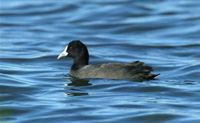 Millions of wild birds that breed in Arctic regions take flight from
their homelands and travel along several routes to reach the warm
wintering grounds.
Millions of wild birds that breed in Arctic regions take flight from
their homelands and travel along several routes to reach the warm
wintering grounds.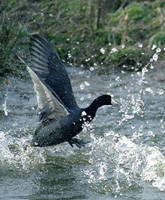 Shanks, Sandpipers, Stints and Dunlin etc. Other wading birds like
Flamingoes, Pelicans, Spoonbills and Ibises can also be sighted on both
upcountry wetlands and on tidal estuaries along the seashores.
Shanks, Sandpipers, Stints and Dunlin etc. Other wading birds like
Flamingoes, Pelicans, Spoonbills and Ibises can also be sighted on both
upcountry wetlands and on tidal estuaries along the seashores.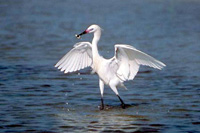 from open areas, since netting of birds is very common in Sindh
province. However, protected lakes like Haleji, Hadero and Drigh offer
excellent bird-watching adventures during the whole winter season.
from open areas, since netting of birds is very common in Sindh
province. However, protected lakes like Haleji, Hadero and Drigh offer
excellent bird-watching adventures during the whole winter season.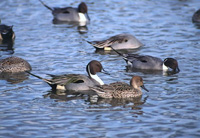 of feeding, roosting or nesting birds can also give the idea of
preferred habitat of different species of birds at different routines.
of feeding, roosting or nesting birds can also give the idea of
preferred habitat of different species of birds at different routines.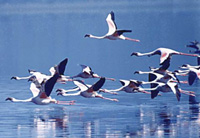 nesting on mangrove trees. Moving further toward tidal links and
brackish lagoons of Indus Delta near Shahbunder, could be more chancing
to watch gigantic flocks of many large and small migratory birds since
the flyways is terminated there.
nesting on mangrove trees. Moving further toward tidal links and
brackish lagoons of Indus Delta near Shahbunder, could be more chancing
to watch gigantic flocks of many large and small migratory birds since
the flyways is terminated there.